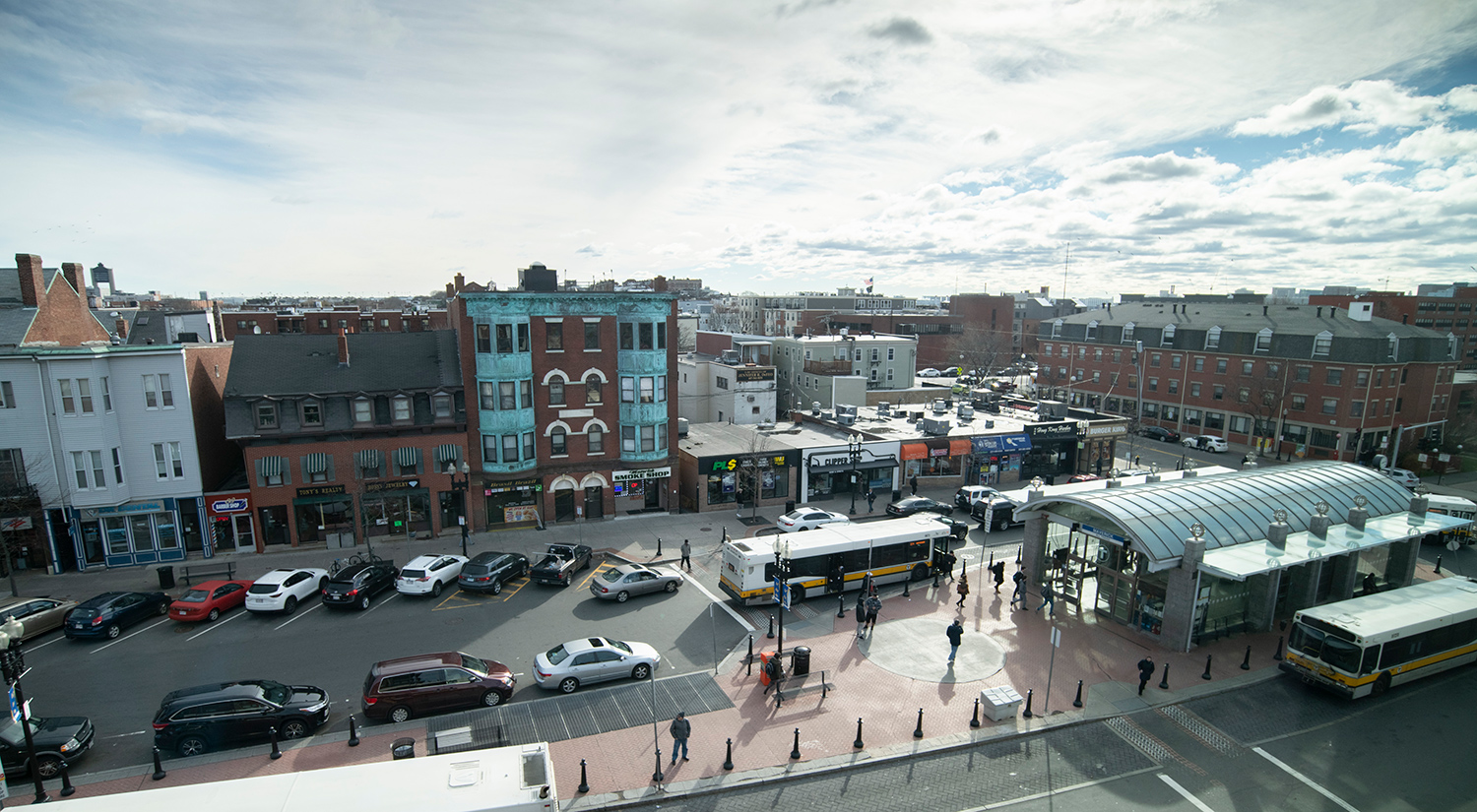On a cloudy fall morning in East Boston’s Maverick Square, two elderly women push their walkers with urgency to the door of a red brick neighborhood center.
“We’ll want to get our seats first,” one tells the other.
But the center—run by the East Boston Neighborhood Health Center (EBNHC)—is already bustling. Thirty-five older adults sit at long tables, concentrating on crosswords, flipping through ad circulars, sipping coffee, and chatting. A whiteboard on the wall runs down the day’s activities: newspapers, puzzles, knitting, art, exercise, an afternoon movie.
When Natalie Alas, MSW ’16, enters the room, a man named Marcos*, in a Red Sox cap and camouflage shorts, greets her warmly in Spanish. He presents a gift wrapped in white plastic (a mango), then heads downstairs to the exercise bikes.
The members of this group, however, aren’t only here for socializing and recreation, explains Alas. Some will also meet with her for 15- to 60-minute counseling sessions, discussing feelings of depression, anxiety, and trauma that, she says, “they’ve often never talked about before.”
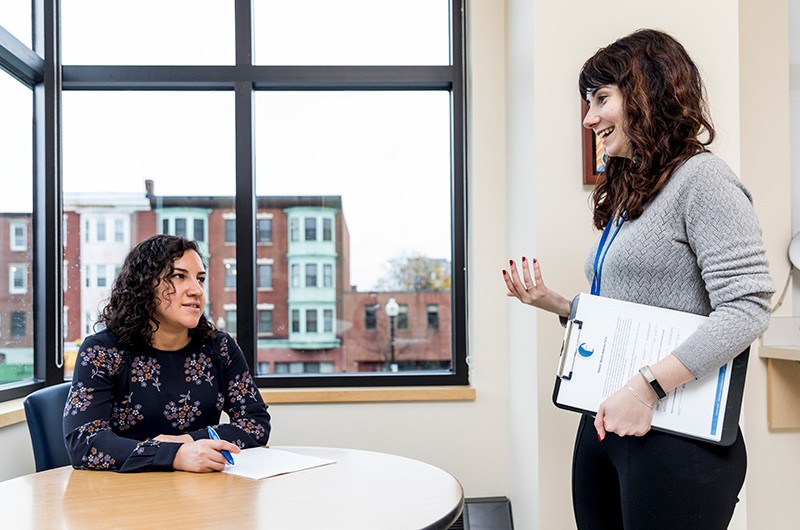
Natalie Alas, MSW ’16, and Laura Zocchi, MSW ’16
Alas is one of six recent alumni from the Boston College School of Social Work who work at the EBNHC, one of the largest community health centers in the country and a hub for a rapidly changing neighborhood. Scattered across its Maverick Square campus, the BCSSW social workers see patients of all ages, from newborns to 97-year-olds. Taken together, their work reflects the expansive mission of the EBNHC: to serve a largely Latinx, culturally rich, and hopeful community struggling with addiction, mental illness, complex medical needs, immigration status, housing instability, domestic violence, gangs, and poverty.
The concentration of alumni at the health center also signifies a growing commitment at the BCSSW: to prepare bilingual social workers with deep knowledge of the cultural beliefs and systemic factors that can prevent Latinx people from seeking mental health care. “The question for us always,” says Alas, “is how can we work with our patients to decrease these barriers?”
***
The EBNHC, according to its website, was founded in 1970 to provide health care to a community cut off from the big teaching hospitals of downtown Boston by Boston Harbor. Once an enclave for Italian American families, the neighborhood of 40,000 has become home to many Latin Americans since the 1990s; current city data indicates it has the largest concentration of Central American, Mexican, and Colombian people living in Boston. Last year, 71 percent of the health center’s 72,000 patients were “Hispanic/ Latino,” as reported by the Health Resources and Services Administration.
Ximena Soto, MSW ’98, assistant director of field education at the BCSSW, describes the health center as a model of behavioral health integration in primary care—making it a dynamic practice site for BCSSW interns and graduates. In addition, she says, its sensitivity to adapting interventions to Latinx patients’ needs aligns strongly with the goals of the BCSSW’s Latinx Leadership Initiative (LLI), a program that prepares students to work effectively with Latinx communities through targeted courses (many taught in Spanish), research opportunities, and field placements. Four alumni at East Boston are graduates of the initiative, and currently, two LLI students are interns.
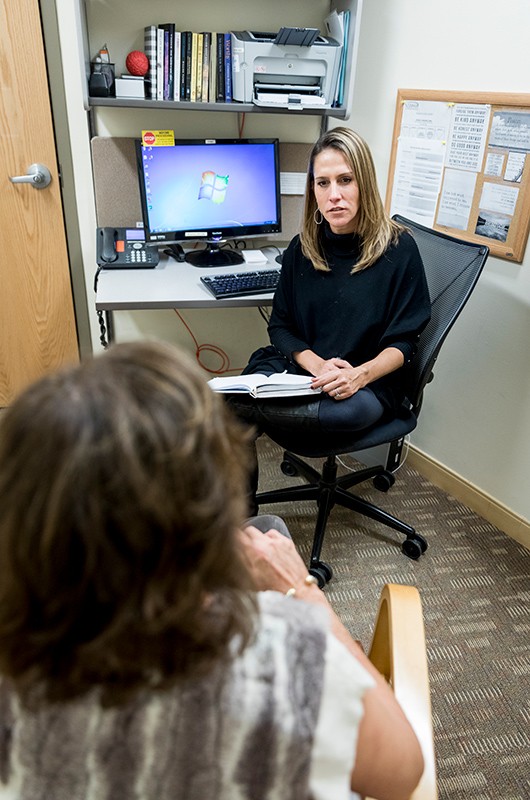
Yvonne Castaneda, MSW ’18
This spring, Yvonne Castaneda, MSW ’18, turned her internship into a full-time position as a behavioral health clinician in adult medicine at the health center’s Gove Street clinic. A graduate of the LLI program, Castaneda works on a multidisciplinary primary care team, providing interventions on the spot in clinic rooms in addition to outpatient counseling.
Her role is not long-term care, she explains: “It’s figuring out how to move the needle a little so that patients can walk out the door and be okay.”
The challenge, she adds, is that often patients have experienced more trauma—from border crossings, violence, infidelity—than she can address in a primary care visit or 45-minute follow-up. “If we open up all that upset,” she says, “there’s no guarantee they’ll come back in two weeks.”
Her strategy, then, is to remind patients of their resilience—how they crossed the border without documentation, survived assault, and made their way to Boston without knowing English; how they got a job, then another, and raised a family. “I tell them, ‘Help me understand how you think you aren’t strong?’” says Castaneda.
Upstairs in the pediatrics department, José Rincón Salazar, MSW ’17, uses a similar integrated behavioral health model with children and adolescents with depression, anxiety, PTSD, and suicidal ideations. He, too, draws on personal histories and traditional values to decrease stigma and improve outcomes. Working closely with a physician—often seen as “the authority” by Latinx families, he says—helps to educate parents that “mental health care is health care.”
Both Castaneda and Salazar make referrals beyond the clinic for patients who need long-term therapy or community resources. Patients age 55 and up with chronic conditions may go on to see Alas and Laura Zocchi, MSW ’16. As part of the Neighborhood PACE Program, an all-inclusive care initiative coordinated by the EBNHC, Medicare, and MassHealth, Alas and Zocchi work with patients at two neighborhood centers with in-house primary care clinics. They provide case management and trauma-focused therapy as well as help oversee patients’ medical and social needs.
This summer, Alas observed that many of her patients felt hopeless and anxious over recent U.S. immigration policies, expressing fears about deportation, their families’ fates, and housing eviction. In response, the social work team identified 21 patients who might be interested and eligible for U.S. citizenship. They then managed the daunting application and exam process, collaborating with clinic doctors to write waivers for patients with dementia. To date, nine patients have received notices of naturalization, reports Alas.
“They come to us with their letters for the citizenship ceremony in tears,” she says, “just crying from happiness.”
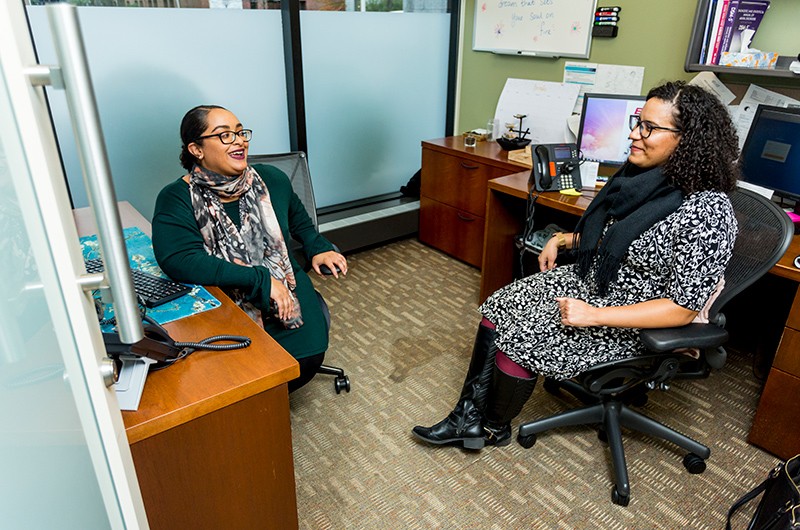
Thelma Terrero, ’14, MSW ’16, and Luzelly Frias, MSW ’16
Thelma Terrero, ’14, MSW ’16, and Luzelly Frias, MSW ’16, also provide ongoing support to patients—in their case, infants through adults up to age 65. Part of a new multidisciplinary “Complex Care” program launched in March, they work for three to four months with individuals whom the EBNHC or MassHealth recommends for intensive services. These are patients, says Terrero, with complicated medical and mental health needs, including substance abuse, “who miss medical appointments, end up in the emergency room, and are frequently hospitalized.” Young patients, adds Frias, struggle with depression, autism, oppositional defiant disorder, and ADHD.
Based at the EBNHC’s main building at 20 Maverick Square, Terrero and Frias take on the barriers of stigma, time, poverty, and transportation instability by “going wherever the patients need us,” says Frias. They counsel patients at the clinic, but also in homes, at school, and over the phone.
Already, say Terrero and Frias, the approach is proving effective, even life-saving. Recently, they were able to help a young woman leave a domestic violence situation, talking with the patient by phone as she loaded her belongings into a cab. Once out of the relationship, they report, the patient quit smoking, stayed sober, and got a job. Another woman—pregnant, undocumented, and facing eviction—secured housing with the team’s support.
***
Terrero describes the need for culturally sensitive social work at the EBNHC as “endless”—an observation echoed by her five BCSSW co-workers.
To help handle the demand, she, Zocchi, and Alas have enrolled in the Seminar in Field Instruction, an eight-session course offered by the BCSSW to train licensed social workers to become field supervisors for MSW interns. Their section is one of two that Soto is teaching in Spanish for clinicians working in Latinx communities. It covers the same topics as the sections in English, says Soto, but with a cultural lens to help first-time supervisors guide students toward more sensitive practice.
Understanding the “sublayers” of values, beliefs, and dialects that distinguish diverse Latinx populations is critical at the health center, explains Zocchi. It can be the difference, she notes, between recognizing that a patient’s trauma response is not a paranoid delusion but the expression of a traditional belief. Other effects of this approach are more subtle, she says, pointing to offerings such as “heritage celebration days” in the neighborhood center’s activities programming.
As another afternoon in her center winds down, Zocchi walks through the now empty activities room, bouquets of small handmade flags of patients’ home countries on its tables. “In the middle of all this anxiety, all this instability,” she says, “we’re giving our patients a community where they feel welcomed and safe.”
*Name changed to maintain patient confidentiality
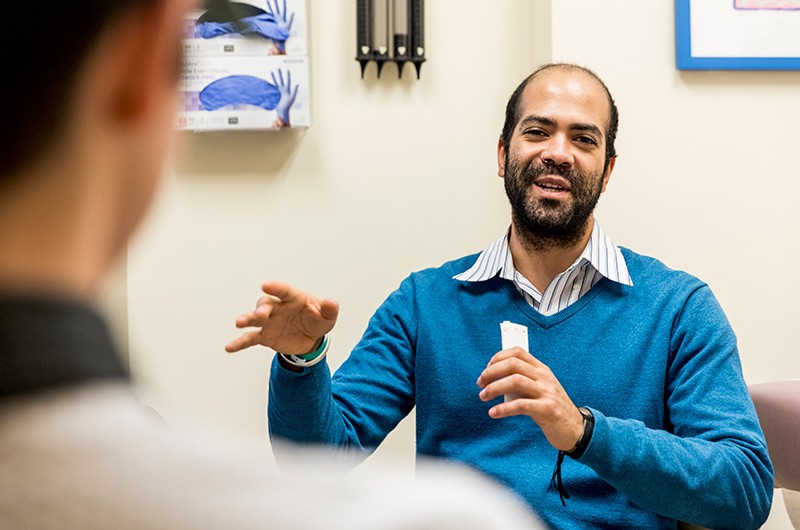
José Rincón Salazar, MSW ’17
Photography by Tony Rinaldo and Caitlin Cunningham.


